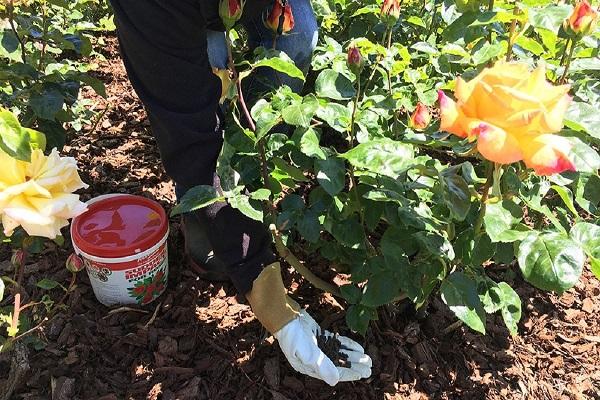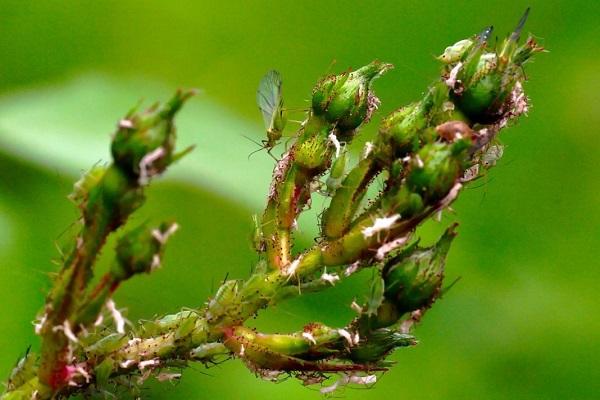Description and rules for growing floribunda rose varieties Samba
Samba rose is an excellent ornamental plant, which is very popular among flower growers. This culture has an interesting color. The flowers are yellow with orange-red edges. To succeed in growing a crop, it is worth providing it with complete and high-quality care. It should include timely watering, fertilization, pruning.
Description and characteristics of the variety
Samba Pati rose belongs to the floribunda category. Translated, this means "profusely flowering". The culture lives up to its name, since flowering lasts all summer. At the time of blooming, the flowers have a yellow tint with a scarlet border around the edges. Then they take on a bright scarlet color with small yellow stripes.
Blooming inflorescences reach 8 centimeters in diameter. However, they practically do not smell. The culture reaches 90 centimeters in height. It is characterized by its compact size. The width does not exceed 60 centimeters. The leaves are dark green in color and have a shiny texture.
The plant is resistant to frost and unpretentious care. The culture tolerates rainfall normally. Cut flowers can stand in water for up to 15 days.
Pros and cons of Samba rose
The key advantages of the variety include the following:
- lush and long flowering;
- disease resistance;
- frost resistance.
The only drawback of the plant is the complete lack of smell. However, for allergy sufferers and people with increased sensitivity to fragrances, this can be considered an advantage.

The subtleties of planting a flower
To achieve success in growing a crop, it is recommended to carry out planting work correctly.
When to plant?
Roses are allowed to be planted in spring or autumn. In the first case, it is recommended to do this after full warming up of the soil. In autumn, the culture is planted in September or October - it all depends on the climate of the region.
Landing site
This culture develops normally in different areas. To achieve lush flowering, the bushes are planted in well-lit areas. It is important to choose areas that are well protected from drafts and wind.

Preparation of seedlings
If you plan to plant a plant with an open root system, you should first soak it in water. This will help to saturate the roots with moisture and help them straighten out. Bushes with closed roots can be placed in the groove along with the soil.
Planting process
For planting a culture, you need a hole 40 centimeters in diameter and 40-50 centimeters deep. The pit should be filled with humus, peat and sand - 1 bucket each. You will also need to add half a bucket of fine clay and 1 glass of ash and superphosphate each.
The rose seedling must be installed in the center of the groove on a hill from the soil. In this case, it is recommended to spread the roots evenly in a circle.
The grafting zone should be 3-4 centimeters below the ground surface.

It is recommended to compact the soil, moisten and cover with a mulch layer. For this, it is permissible to use humus, sawdust, hay.
After loosening, the mulch layer should be renewed.
Plant care rules
In order for a culture to grow and develop normally, it must be properly looked after.
Watering and fertilizing
Watering the rose is worth once a week. For this, it is better to use warm, settled water. It is recommended to moisten the soil in the morning or evening. In dry weather, the amount of watering is increased. 1 bush requires 8-10 liters of water.

During the season, the plant needs to be fed several times:
- for the first time, the culture is fed after blooming, using mullein infusion;
- the second feeding is carried out after 2 weeks with urea;
- for the third and fourth time, it is worth using mineral products based on potassium, magnesium and phosphorus;
- the fifth feeding is performed at the beginning of autumn - for this, an ash solution and potassium sulfate are used.
Formative pruning
The shrub requires moderate pruning. You should not shorten the shoots too much, as this provokes a weakening of the culture. Insufficient pruning will result in a branchy bush with weak branches. It is better to cut the culture for 7-8 buds. The procedure is carried out in early March. In the same period, it is worth removing damaged and frozen shoots.

In the fall, the rose should be pruned before the shelter for the winter. It is recommended to carefully remove the leaves from the bush, and cut the stems by 15-20 centimeters. From the third year of life, they start anti-aging pruning. Old shoots 2-3 years old should be removed from the central part of the bush.
Shelter for the winter
For the winter, the culture should be covered. Before carrying out warming procedures, it is recommended to remove leaves, flowers and unripe tops from the bush. In this case, the culture should be covered with earth and covered with leaves or spruce branches.
Prevention of diseases and pests
The rose of this variety is resistant to high humidity, which provokes the development of fungal infections. For the purpose of prevention, you can spray the culture with a solution of copper sulfate. It is also permissible to use Bordeaux fluid for this purpose. The procedure is carried out in the spring. This should be done once every 2 weeks.

Also, the culture can suffer from attacks of various pests:
- Rose aphid. In this case, the leaves are curled and covered with a sticky bloom. Karbofos, Actellik help to cope with parasites.
- Spider mite. In this case, the leaves are covered with fine white cobwebs. Karbofos, Commander helps to destroy pests.
- Rose leaf roll. When attacked by this pest, the leaves curl along. In such a situation, the culture is treated with Decis or Karbofos.
- The penny is slobbering. In this case, the shoots are covered with foam lumps. Spraying the bushes with water and treatment with Intavir or Rovikurt helps to cope with pests.
- Rose sawfly. This pest leads to deformation and drying of the shoots. In such a situation, the culture should be treated with Decis or Chlorophos.

How to propagate a Samba rose
It is worth propagating the Samba rose by vegetative methods:
- Cuttings. The procedure is performed during the beginning of lignification of the branches. Cuttings are harvested from shoots 1-2 centimeters thick. Then they are buried in loose soil and covered with a film.The plant should be planted in a permanent place for 3 years.
- Graft. Rosehip is used as a stock for the procedure. To do this, make a T-shaped incision on the root collar, place the sleeping bud of the Samba rose in it and fix it with a film.
- Division. This method is only suitable for self-rooted plants. It is worth sharing the culture in spring or autumn. To do this, you need to dig it up and cut it into several parts with a sharp knife. Each fragment must have at least 3 shoots.

Application in landscape design
Rose Samba looks great with conifers. In this case, it is recommended to choose low crops. The combination with hosts looks good. It is also permissible to combine the culture with boxwood. A perfect background for a rose will be a black elderberry or boxwood.
It is permissible to use bushes to decorate garden paths or borders. The culture can be used in group plantings. In this case, the plants are planted at a distance of 1 meter from each other.
Rose Samba is an attractive decorative culture that is often used in landscape design. To achieve success in growing a plant, it is worth providing it with complete and high-quality care.









